A brief history……
During and after WWI, money, especially small change, was in short supply and this was down to several reasons. There had been an expansion of the German occupied territories and too much ‘real money’ had flowed to those new areas. Nickel coins were gradually withdrawn from circulation so that the metal could be used in the war efforts and people’s natural tendancy to hold onto something of value, (ie) coins and banknotes, furthered the shortage. The value and price of silver had also risen dramatically so all the silver coins vanished from circulation, as their intrinsic value was higher than their face value. There had been a lack of small face-value regular change since 1916 and this was felt throughout the entire country. The striking of 50pf coins had taken far too long, it was stated by the national bank……possibly due to lack of workers because of the war. The coinage was now being made from zinc and iron and then aluminium………..and today, there are still many metal notgeld coins from around 1917 that can be found by the collector. The declining value of the mark ensured that gold and silver was hoarded and if something had to be paid for, the paper money was used. As the wealth of Germany declined even further, metal almost disappeared from circulation and everyone had to rely on paper money. Some notgeld show this excessive production of paper money in their graphics:

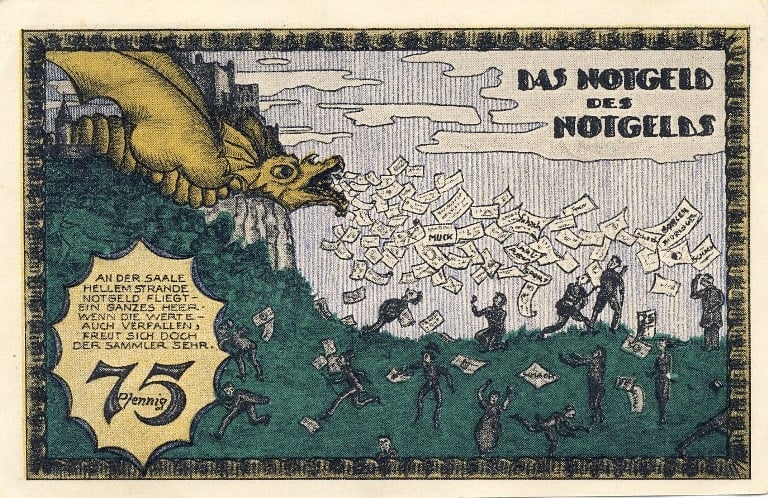
To alleviate this problem of the shortage of small change that was needed for day-to-day business, the state bank (Reichsbank) appears to have agreed to allow towns, villages and municipalities to issue their own money………..or at least turn a blind eye to it all. The Reichsbank even hoarded its own reserves of money. These issues, initially were actual emergency issues. The word not means emergency or necessity and geld means money, so notgeld means emergency money. Notgeld was mass-produced and was a phenomenon that was witnessed through everyday people who were just living their lives. Notes denoted with ‘Darlehenskassenschein‘ (a state loan note) were issued between 1914 (right at the start of the Great War, in order to help finance it) and 1922; not actually technically currency i.e. banknotes, as they were not backed by a treasury reserve, but they were used as currency and were de facto currency. They were similar to and operated like an ‘I.O.U’. A law of the 4th August 1914 made it compulsory for all financial institutions of the state to accept them in payment. Starting in 1914 and moving through to the very early 1920’s, notgeld issuing became almost uncontrollable. It forms part of the history of the German economy and monetary system of the times. Many of the graphics and depictions on these notgeld, detail the suffering of the German State, the pride of the nation and the humour which helped them see through the economic situation they were in. The notgeld issues, challenged the exclusive issuing privilege of the Reichsbank itself and because the issuers did not want to provoke, most pieces will not have the word ‘Geld’ by itself on them. Instead, they have the terms like ‘notgeld’ (emergency money), ‘Gutschein’ (voucher), ‘wechselgeld’ (exchange money).’ …..things like that. There are several different terms for a collector to look out for. (I’ll create an article with examples about them I think…..)
These highly collectable ‘German Gems’, interesting old banknotes, or historical documents with their different colourful motives and designs, can usually be found at flea markets and collector fairs etc. and will fascinate the collectors out there. They were souvenirs collected at the time, by people who wanted to ‘document’ their experiences of extra-ordinary times and they have been collected ever since. They also served as a reminder to people of the substitute currency and a reminder of the inflationary period. They have certainly kept my interest for 50 years now, with so many discoveries of hidden meanings and the relationship to the notgeld issuing bygone era!!
Notgeld was issued by several countries, but this website is primarily interested in the non-metal notgeld issues of Germany……. and also, but to a much lesser extent, Austria.
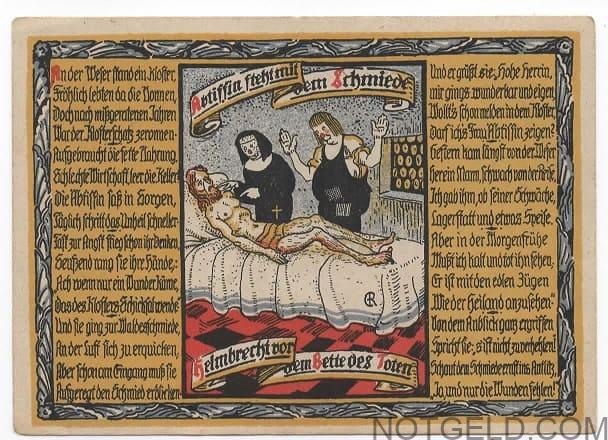
The note above tells of a ‘miracle’ – the ploy of an abbey to get its coffers full again! (Full translations are available for my GNCC members)
(‘Notgeld’…..awaryjne pieniadze” i ich niemieckie wydania sa z lat 1914-1923. Wydawane byly glownie z powodu braku drobnych. Wiekszosc jest bardzo kolorowa i pieknie zaprojektowana. Kolekcjonerzy doceniaja ich rozmaitosc (serienscheine). Sa rozsadne w cenie, dlaczego wiec nie rozpoczac ich kolekcjonowania czy rozszerzyc dodatkowo kolekcji? Obecnie uzywam niemieckich nazw miast z ktorych pochodza, ale z czasem bede dodawal takze polskie nazwy miast.)
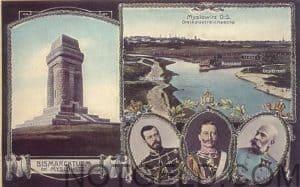
A picture showing the ‘3 Emperors Triangle’, of the old Osterreich-Ungarn (Austrian-Hungarian) Empire, a place and point where Germany, Russia & Austria all converge. Below is a very scarce set of verkehrsausgaben notgeld from Myslowitz!
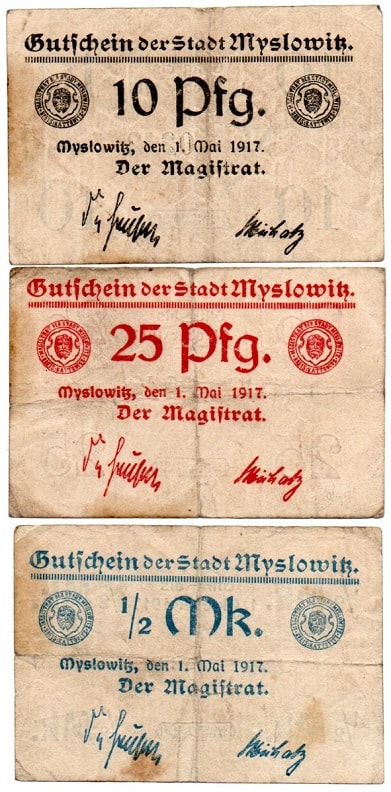
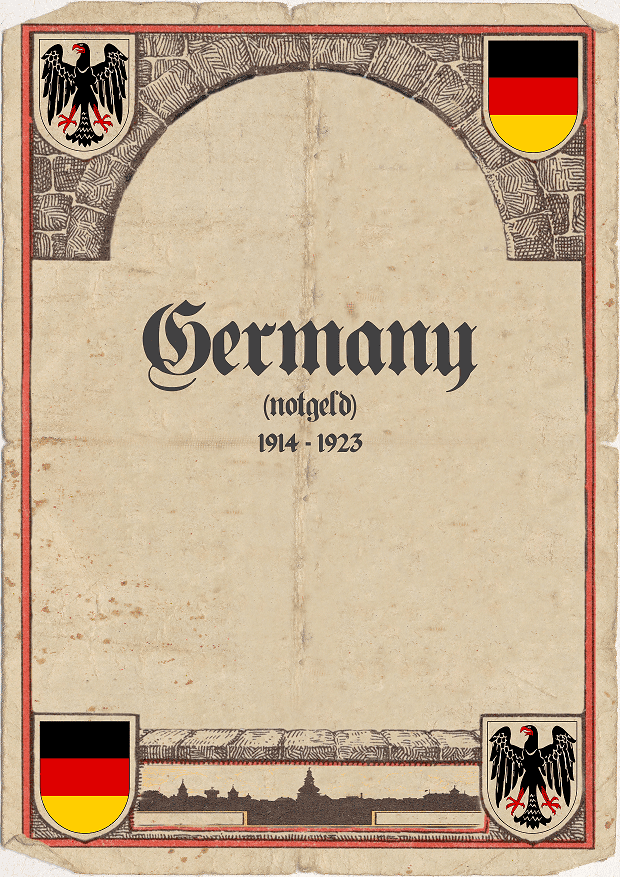
As time went on, more and more towns and villages jumped on the band wagon to print their own money, so that eventually, individual towns were able to produce notes that depicted their town’s buildings or things that were important to their identity. If the town produced a commodity, eg) silk (Bielefeld), then the notes quite often depicted these manufacturing processes. In the above example, several of the Bielefeld notgeld issues were actually printed on silk and linen. Local ‘heroes’ could be depicted as could scenes from around and about, so the beauty of the notes’ designs furthered the demand of the collectors. It was a popular hobby of the times…….collecting these notgeld issues…..with some people seeing notgeld as a record and recorded history of the turbulent times!
Different bodies started to issue notgeld that included (but were not limited to)…….city authorities, town authorities, municipal savings banks, parish councils, chambers of commerce, church authorities, political parties, cultural societies, trade associations, military associations, transportation companies…………………and also independent businesses like cafes, hotels, spas and health resorts, cinemas, shooting clubs, sports clubs and tournaments, festivals, fairs and other ‘private’ issues. There were even notgeld exhibitions (‘notgeld sammlerbund’) where notgeld were produced for that specific event!
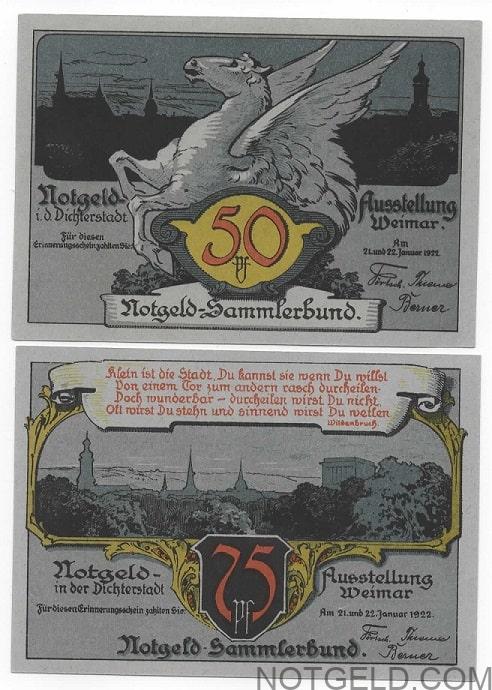
I am fascinated by the opportunity the local artists seem to have had to design money – not primarily burdened by the rules applied in designing official banknotes (with all the anti currency-fakers devices and tricks they need nowadays).
In any case, there was plenty of ‘swindling’ going on in the notgeld issuing arena itself!! Over time, the validity periods on notes were shortened to the extent that they were only valid for a few days. Even that was stretched to the extreme……and notgeld were issued with invalid validity dates (the date had already passed). There were issues from towns or places that didn’t exist and issuing authorities charging collectors of the time, ‘admistration costs’ or selling pieces above their face value because they knew the collectors wanted their notgeld issues.
So most of the notgeld issues were official documents, signed by the Burgermeister, commissioned by the city and stamped with the relevent authority stampmark – they were not an individual artistic gesture (in most cases), but a collective expression of feelings, fears, love for places and peoples, hatred against some ethnic groups or professions, outcrying of grief and the despair felt by the German people after the Treaty of Versailles……………..they are a history lesson in themselves!

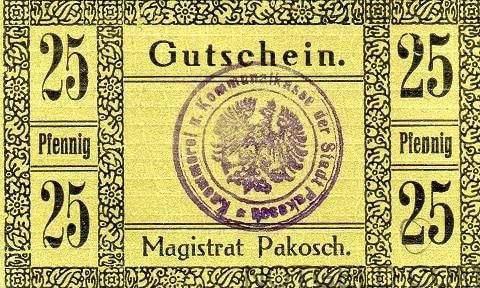
So many of these notgeld were so colourful, that it was inevitable that collectors would soon become interested in them – investing time and effort in research and cataloguing and better understanding why they came about and why their issues were so prolific. Emergency money collecting had first become really popular when returning soldiers, from WWI, had returned to civilian life and became interested in them, after 1918. All the slight variants in the pieces made (and still make) notgeld collecting so interesting!!
(Can you spot the differences with the 2 notes above? I’ve penciled around one of them (the number ‘2’)………….the spacing of the word ‘Gutschein is another………but there are more to see or find………look at the location of the 2 round flowers in the top border for example…….) Easy to miss!!
When a collector obtains a new piece of notgeld, they should be sure to compare that piece with what they already have – it may not be the same piece! Watch out for and study the possible different paper, different colourings, different watermarks…….etc.
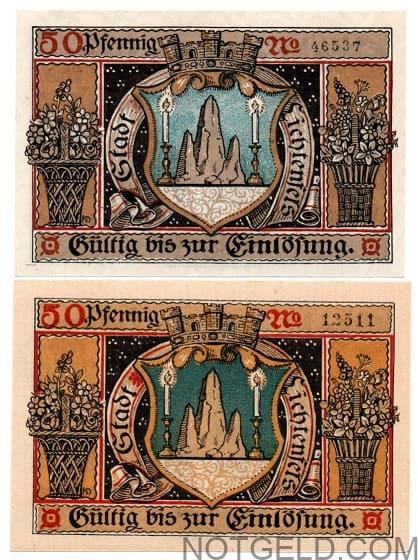
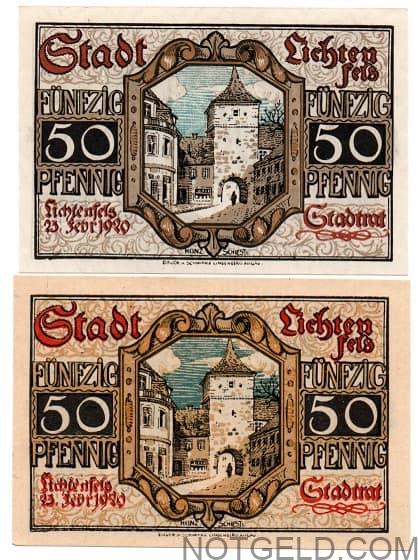
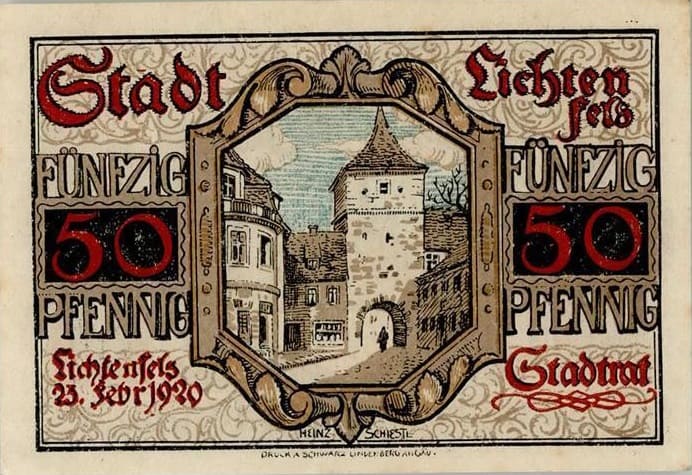
Notice the ’50’ in white or red!
At the beginning of the war, 1914, the notgeld issues were drab and bland, with many issues having been signed and counter signed by hand. Some early notes in my collection have 3 hand written signatures on them. In 1921, when the phenomenom was at it’s height, thousands upon thousands of ‘sets’ were being produced…..to meet the demand from the collectors and not to meet the shortage of small change, the original purpose of notgeld issues.
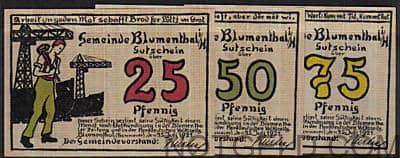
Above scan shows a set of 3 typical ‘serienscheine’ pieces, issued by the town of Blumenthal – (Lm.117). Below is a much scarcer set of 3 issued in Lage – (Lm.737)
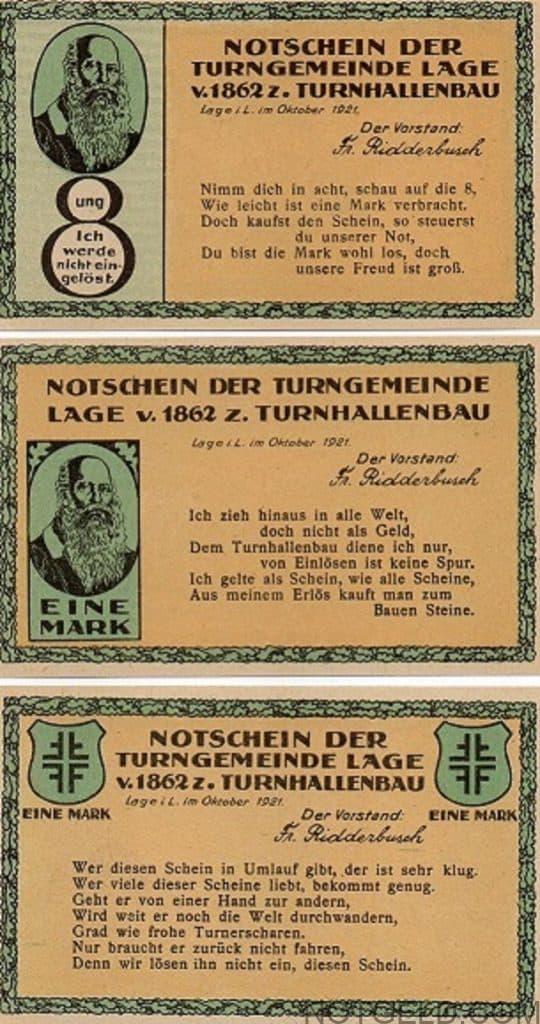
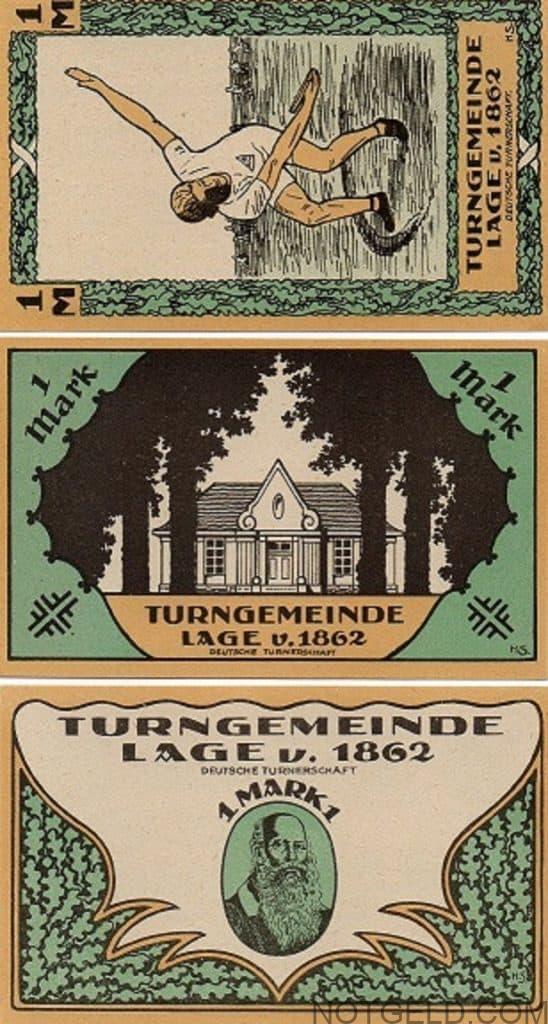
In 1923, notgeld became affected by the ‘runaway’or hyper-inflation that had hit the German economy and so inflationary notgeld began to emerge. Notgeld were issued with face values of billions of marks (1 billion was 1,000,000,000,000)!!!
Notgeld was usually only valid in its own town, or local area, ……..as stated on the following verkehrsausgaben 10pf notgeld issue from Herzberg. It states:
‘Nur gultig im Stadtbezirk Herzberg‘……’Only valid in the town district of Herzberg‘
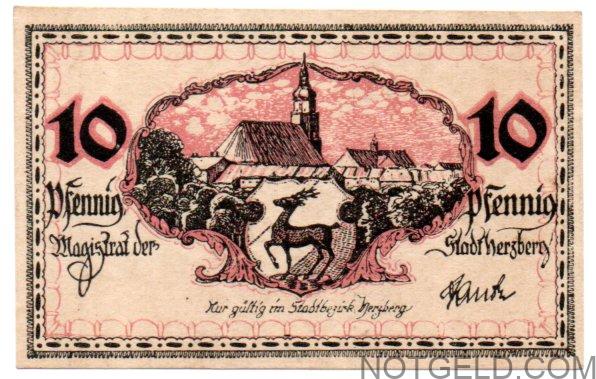
and this 50pf serienscheine piece from Bargteheide which states:
‘DIESER SCHEIN IST GULTIG IN ALLEN BARGTEHEIDER RESTAURANTS, KAFFEES, U.SONSTIGEN GESCHAFTS-LOKALITATEN.’
‘THIS NOTE IS VALID IN ALL BARGTEHEIDE RESTAURANTS, CAFES,…. AND OTHER LOCAL BUSINESSES.‘
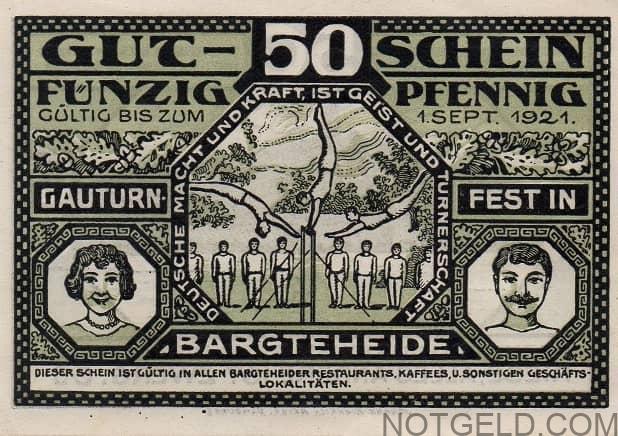
But……… notes were accepted in other places as well, especially at the time of the high inflation. Sometimes notes travelled through the whole German Reich (empire), more than 600 miles.
Notgeld pieces will sometimes have a validity statement or date (valid – Giltig) or may have been cancelled (not valid – Ungiltig). This spelling can either be with the ‘i’ (Giltig / Ungiltig) or a ‘ue’ (Gueltig / Ungueltig). Both spellings were used between (at least) 1914 and 1923, so you can see below the printed words with the 2 different spellings:
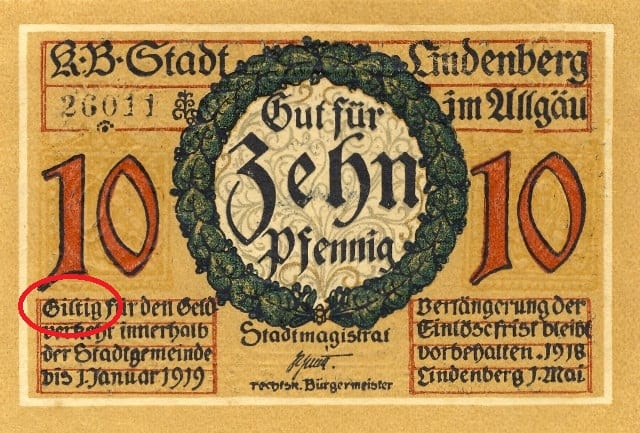
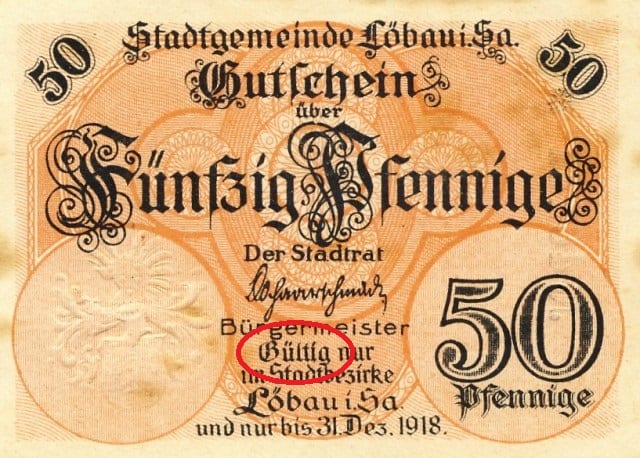
****************************************************************************************************************************
If a German banknote has the word Reichsbanknote (or Darlehnskassenschein) on it, then it has been issued by the state. This would be rather like an English banknote having been issued by the Bank of England. If it is a ‘Reichsbanknote’ or ‘Darlehnskassenschein’ then it is not a piece of notgeld (‘local issues’ – notes issued by towns and villages etc.etc.) Most notgeld will have the name of a town on it. Some will say something like this; Gutschein der Stadt………Gutschein der Gemeinde……… Gutschein translates as ‘voucher’.
(Darlehnskassenschein translates as a State Loan Currency Note. They went into circulation right at the start of WWI and were technically not actually banknotes (i.e not issued by the Reichsbank or any other bank……. but by the Reich Debt Adminstration; and not backed by gold or any other standard, but – technically – by the state’s industrial and land holdings). The law which brought them into existence obliged banks and other financial institutions to accept them in payment at face value. I presume that as they weren’t technically currency, their proliferation should theoretically not have affected the value of the mark as a currency. The fact that they clearly did shows that what’s good in theory is not necessarily going to work out well in practice. In some cases though, these Darlehnskassenschein notes were actually issued by specific towns…………..but generally see them as similar to Reichsbanknotes, issued by the State……………and therefore NOT notgeld issues).
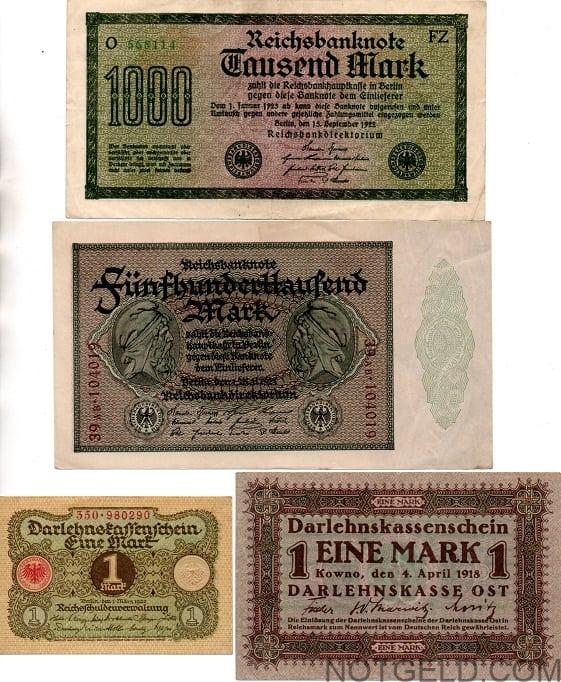
****************************************************************************************************************************
I am sorry that I am unable to answer any queries relating to any of the following….. ‘normal’ (not overprinted) Reichsbanknotes/Darlehnskasenschein and/or coins!
The overprinted propaganda Reichsbanknotes have become an off-spin interest for me, so I welcome emails about those!
If you join my GNCC, there are topics for all types of notgeld, which other notgeld collectors will hopefully share in your interests. Me……just interested in paper issues of Germany between 1914-1923, with an original face value of 1000m or below. Every collector will have their own boundaries of what they collect. There are no rules with collecting. Collect what you like and how you like!!
ENJOY THE NOTGELD COLLECTING HOBBY!!!
